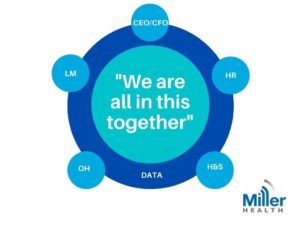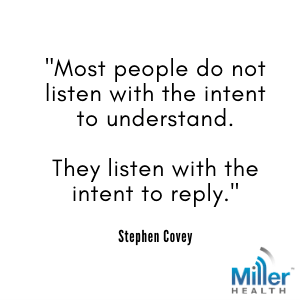We’re all in this together. Or are we?
How everyone in a business can support employee health and wellbeing.
How do you use data to manage employee health and wellbeing? With the digital age well and truly here, businesses are blessed with a wealth of information to help them as they manage their employees. We can review trends, confirm the scale of a situation and establish the cost of a problem.
Yet too often, data is left out of the equation when we investigate health and wellbeing issues within a business. Mental health issues are put down to someone “going through a tough patch” or “not being up to the job”. Backache is attributed to an incorrect workplace set-up or an historical sporting injury aggravated by poor posture.
A more holistic approach is needed to find the broader problem.
‘We’re all in this together’ is a phrase we’ve heard increasingly over the past year. The Coronavirus pandemic has impacted us all, albeit in different ways. But when I see employee health and wellbeing problems being labelled as a “one-off”, it makes me question whether a business and its employees truly are “all in it together”.
When it comes to employee health and wellbeing, we MUST all be in it together.

Everyone in an organisation has a part to play in ensuring better employee health and wellbeing. “How so?” you may ask.
The answer is for the stakeholders to share the information and data they have, even if it’s not immediately clear that there’s a link.
A root cause approach to employee health and wellbeing
If your business encounters a problem with a team or individual, the best way to start dealing with that problem is also the simplest – ASK
By asking, communicating, getting feedback and taking the time to understand what is going on, you will get the data you need to help you uncover the root cause of the situation. With this knowledge you will be able to resolve problems more effectively.

1. Find out what the problem is by asking
- Who is involved?
- What is the issue?
- What is the outcome?
- What is the likely cost of the situation?
- Consider factors such as sickness absence, presenteeism, poor performance and so on.
2. Communicate with those involved
It is only by sharing information (whilst respecting confidentiality) that we can develop a joined-up approach to any problem.
Let’s consider a situation where it’s apparent that one individual has had several spells of absence. Before you refer that person to occupational health, start your own fact-finding mission to help you to uncover the root of the problem more quickly.
Ask the CEO or CFO – what is going on in the business? Is there a change of some sort or a restructuring that may directly or indirectly affect this person?
Ask the finance department – what is the cost of this problem? A quantified cost helps increase the urgency with which problems are addressed.
Ask health and safety – what are the risks in the employee’s job? Has there been any change in the job role?
Ask the line manager for their opinion on what is happening. The manager knows this person best and should have the individual’s trust.
Is there anyone else you could ask? Team members? The more information you can gather, the better – but remember to honour confidentiality and stay discreet.
3. Listen to feedback and investigate

Once you’ve asked, it’s time to listen.
However, listening is a much-underrated skill. It’s easy to ask a question and then tell someone your interpretation of what you think they said. The skill lies in asking a question and then truly listening to what that person is telling you without allowing your preconceptions and beliefs to interfere.
Once you’ve heard responses from the people you are asking questions of, it’s time to ask more questions to help you understand the situation in more depth. It might take some time to get to the bottom of it.
Using this approach will mean you get a wider range of views and a more diverse response from the feedback. This will lead to a more considered and representative view.
While asking for information, you may find sources of information which aren’t otherwise obvious. You may already have absence tracking tools in place and measures of productivity. But what about other data sources?
An underused data source – a case study
An Employee Assistance Programme (EAP) is a free confidential counselling helpline for employees. It can help with a range of topics but most importantly – mental health queries and debt problems.
In this particular situation, employees knew that the business paid for the EAP service. They had received a note which told them about the benefits of the EAP and emphasised its confidentiality. Despite this, only a few employees took up the offer that the service provided.
With the EAP in place, it was left to its own devices.
The human resources department didn’t have access to the percentage uptake of the EAP service and didn’t review the service with the finance department to understand the cost of the service. What’s more, although the EAP provider offered regular reviews to share details about how the service was being used, these were not followed up on.
As it stood, the EAP was a poor investment. But with a more joined up approach, the data provided by this tool could have provided a gauge on employee mental health (numbers, not individual details) which would be helpful during times of change. A more collaborative approach to employee wellbeing would have emphasised the value of this free-to-employees service, potentially helping reduce employee issues.
This approach would have better reinforced the notion that “we are all in it together”.
4. Agree action, review, adjust and review again.
With a range of data sources and information, you can now review the situation and agree what action to take. Remember that once the action is in place, you will need to review the situation again, make adjustments and continue to revisit the case. Nothing stays the same forever after all!

Resolving employee wellbeing and productivity problems by asking the right questions – a case study
In this particular case, we see a distribution team who were responsible for dispatching products to customers.
Three members of a distribution team had become stressed and one team member went off sick with depression. Their productivity had also dropped. The occupational physician sensed that there might be things happening in the business and arranged to meet the HR Director and asked, “what is going on in the business that might be causing this problem with the team?”
The HR Director and occupational physician then met with the Finance Director, who told them about recent changes taking place in that part of the business. As part of this change, the teams who sent products to the distribution team were being retrained.
Upon investigation, it became clear that the training wasn’t being delivered effectively resulting in products not meeting quality standards. On top of this, they were being delivered late to the distribution team who were also having to send some of them back to be reworked. This was doubling their workload and resulting in angry customers calling to ask where their orders were. Understandably, this was creating ill feeling for everyone involved and the distribution team were bearing the brunt of it all.
This situation was also costing the company dear in terms of reduced productivity, brand image and dissatisfied or lost customers.
The team could hardly have been less “in it together”. Better communication across the company would have prevented the human and business cost of this problem in the first place. But thanks to the thoroughness of the investigation, the situation was straightforward to resolve.
Building a business that is truly “all in it together”
From my experience, a joined up, collaborative approach can create better and more cost-effective solutions. And this can prevent similar problems developing in the future.
If you would like help developing an approach to employee health and wellbeing that truly reflects a “we’re all in it together” mentality, please get in touch if I can help you or your team…
Thank you
Doreen
Tel: +44 (0)333 900 9280
Email: [email protected]
